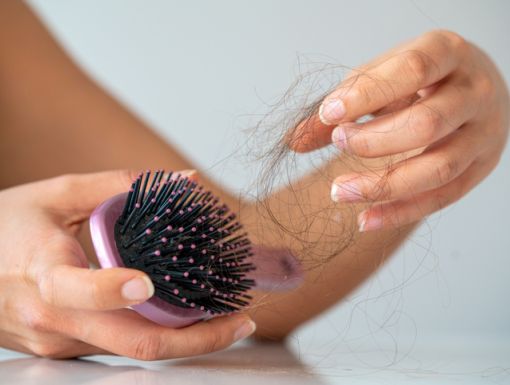
Does COVID-19 Cause Hair Loss?
If you had COVID-19 or if you feel emotionally spent as the pandemic drags on, you may believe you’re literally pulling your hair out.
Well, you might not be pulling it out, but COVID-19 could have a hand in your hair loss. For some, thinning hair is yet another agonizing byproduct of the virus.
Recent studies have shown that COVID-19 infection and the stressors associated with the pandemic are causing “acute telogen effluvium,” a form of temporary hair loss throughout the scalp that usually happens after stress, an illness, or a traumatic event.
The good news for those experiencing this form of hair loss is that your hair should eventually return to normal and acute telogen effluvium is a temporary condition.
The Stress of It All
Hair loss has many causes. Anemia (low blood count), thyroid disease, physical stressors (such as quick weight loss), mental stressors, general anesthesia, being post-partum and major illnesses (especially those causing fever) can all trigger acute telogen effluvium. As the COVID-19 pandemic drags on, we’re becoming familiar with another cause: COVID-19.
This non-scarring hair loss can be sudden and dramatic for some people. Various forms of severe physical or emotional distress can prematurely cause up to 70 percent of your hair to exit the growth phase and enter into the “telogen” or resting phase of the hair cycle. Your body becomes more focused on repairing itself than on growing hair during the stressful event. Hairs don’t grow during the telogen phase, but they don’t usually fall out either. The resting hairs remain in the follicle until they are pushed out by the growth of a new hair. The hairs will typically be pushed out or shed approximately 2-3 months after the stressful event. Seeing large amounts of hair being shed at once can cause significant distress. A person with this condition does not lose all their hair, although it unfortunately may become noticeably thin.
The American Academy of Dermatology says even if you never had the virus or developed a fever from it, you may still see hair shedding. Stress from any physical or emotional event, including childbirth, major surgery, or a job loss, can also force more hairs than normal into this resting phase. Raise your hand if you have been feeling more stressed and anxious during this pandemic?
Some research on this topic has been conducted. A report in the Journal of the American Academy of Dermatology found a 400 percent increase in acute telogen effluvium cases in the dermatology clinics at two New York City hospitals between March 1, 2020 and August 31, 2020, compared to a similar period before the pandemic.
What To Do
While finding wads of hair on a brush or in the shower can add to your stress, it’s important to try to de-stress as much as possible. Only when the stress ends will the excessive hair shedding stop. When the cause of your hair shedding is due to a fever, illness, or stress, hair tends to return to normal on its own. Give it time. As your hair grows back, you’ll notice short hairs that are all the same length by your hairline. Most people see their hair regain its normal fullness within six to nine months.
You should see a dermatologist if the hair loss persists longer than nine months.
You may also want to see a dermatologist if you suspect that your hair loss is caused by something other than telogen effluvium from stress or a fever.
Learn more about dermatologist Kelli Hall, MD



